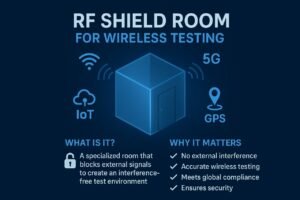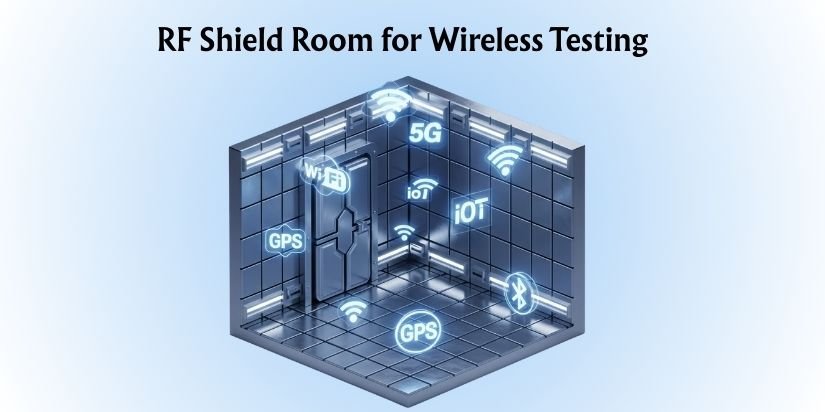In today’s connected world, every device communicates wirelessly—whether it’s a smartphone, an IoT sensor, a medical device, or advanced automotive electronics. With the growing reliance on wireless technology, the need for accurate and secure testing has never been greater. This is where RF Shield Rooms come into play.
An RF Shield Room (Radio Frequency Shielded Room) is a specialized enclosure designed to block external electromagnetic signals, providing a controlled environment for wireless testing and measurements. By isolating devices from outside interference, engineers can test performance, compliance, and security with complete accuracy.
In this article, we’ll explore the role of RF Shield Rooms, how they work, their applications, benefits, and why they are critical for industries ranging from consumer electronics to defence.
What is an RF Shield Room?
An RF Shield Room is essentially a Faraday cage in the form of a room. It is built with conductive materials such as copper, steel, or aluminium to prevent electromagnetic waves from entering or leaving the room. This shielding ensures that devices under test (DUTs) can be evaluated without interference from external signals like Wi-Fi, cellular networks, or broadcast radio waves.
Key characteristics of an RF Shield Room include:
- Electromagnetic Isolation: Blocks both inbound and outbound RF signals.
- Controlled Test Environment: Maintains consistency for repeatable measurements.
- Flexible Design: Can be equipped with test benches, antennas, absorbers, and measurement instruments.
Why RF Shield Rooms are Essential for Wireless Testing
Wireless devices must operate seamlessly across different environments. However, without controlled testing conditions, external signals can distort measurements, leading to inaccurate results. Here’s why RF Shield Rooms are critical:
1. Interference-Free Testing – eliminates unwanted noise.
2. Compliance and Certification – meets FCC, CE, CISPR, and ETSI standards.
3. Accurate Wireless Validation – ensures signal strength, latency, and throughput analysis.
4. Security Testing – protects against data leaks during sensitive wireless communication.
How Does an RF Shield Room Work?
An RF Shield Room functions based on Faraday’s principle, which states that electromagnetic fields can be blocked by conductive materials.
Key Components:
- Shielded walls, floors, and ceilings (steel, copper, or aluminium).
- RF gaskets and honeycomb vents for sealing and ventilation.
- Filtered power and data lines.
- Absorbers (optional) to reduce internal reflections.
This creates a controlled test environment where no external RF energy enters and no internal signals leak outside.
Applications of RF Shield Rooms
- IoT Device Testing (wearables, smart homes, industrial sensors).
- 5G and Mobile Devices (smartphones, routers, base stations).
- Medical Equipment (pacemakers, wireless monitors).
- Automotive Electronics (ADAS, infotainment systems, V2X communications).
- Defence & Aerospace (radar, avionics, encrypted communications).
- Consumer Electronics (TVs, gaming consoles, smart speakers).
Benefits of RF Shield Rooms
- Improved test accuracy.
- Simplified regulatory compliance.
- Reduced development costs and delays.
- Improved device reliability.
- Confidentiality & data security.
- Scalable for different industries.

Comparison: RF Shield Rooms vs. Anechoic Chambers
| Feature / Aspect | RF Shield Room | Anechoic Chamber |
| Primary Purpose | Blocks external RF signals for interference-free testing | Minimizes internal reflections to simulate free-space conditions |
| Construction | Metallic shielding (copper, steel, aluminium) | Shielded walls + RF absorbers (pyramid or wedge foam) |
| Best For | General RF isolation, functional testing, and security testing | Antenna testing, radiated emission, and performance validation |
| Frequency Coverage | Wide range (kHz to GHz, including 5G) | Wide range, including mmWave frequencies |
| Applications | IoT, medical devices, defense, consumer electronics | Wireless antenna performance, EMC compliance |
| Cost | Generally lower than full anechoic chambers | Higher due to absorber installation |
👉 Tip: Many facilities combine both—using an RF Shield Room for interference-free functional testing and an Anechoic Chamber for advanced EMC/antenna validation.
Designing an RF Shield Room
Key considerations when setting up a shield room:
- Size & Layout – handheld devices vs. large vehicles.
- Shielding Effectiveness (SE) – measured in dB (higher = better isolation).
- Frequency Range – ensure coverage for Wi-Fi, 5G, GPS, Bluetooth, etc.
- Accessibility – shielded doors, cable feedthroughs, maintenance access.
- Integration – compatible with spectrum analysers, antennas, automation.
Future of RF Shield Rooms
With 6G, satellite internet, AI-driven IoT, and defence innovations, RF Shield Rooms will evolve to include:
- Automated robotic testing.
- Smart leakage monitoring.
- Hybrid shield + anechoic solutions.
An RF Shield Room for wireless testing is no longer optional—it’s essential for ensuring product reliability, compliance, and security in today’s connected world. From smartphones and IoT devices to defence systems and medical equipment, industries depend on shield rooms to deliver interference-free, high-performing products.
By investing in RF Shield Rooms, manufacturers gain accuracy, faster compliance, cost savings, and customer trust—making them the backbone of modern wireless testing.

